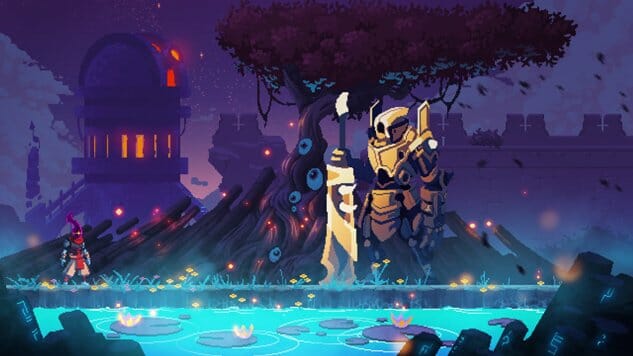Dead Cells Creates Life with a Frankenstein of Game Genres

Dead Cells combines two genres that simply shouldn’t mesh. The roguelike is marked by randomly generated levels that change with every play and the permanent loss of any items the player has accrued when they die. The Metroid-style platformer has the player regularly retrace their steps through a sprawling world after acquiring a series of permanent new abilities that unlock previously inaccessible areas. The two are fundamentally at odds with each other.
A crucial part of games like Metroid and Castlevania: Symphony of the Night is remembering where to go and how to get there, which literally isn’t possible to do in a game that changes every time you play it. Also those games make a pact with the player that, when they find a new ability, they’ll have it permanently from that point on (although sometimes there’s an exception for specific weapons, like the guns in the original Metroid.) Compare that to Spelunky, an archetypal roguelike platformer: when the player dies they start over from scratch, without most of the power-ups they might have found or purchased in their last game. Every game in a roguelike is a fresh start that’s entirely self-contained, whereas Metroids and their ilk present a single, unbroken adventure that will take many hours and several different play sessions to complete.
Dead Cells wants to bring these two diametrically opposed approaches to game design together. Although the seams are readily visible in many ways, with a number of compromises and cut corners making that goal more practical, Dead Cells largely pulls off what should probably be impossible. It captures the spirit of both styles of game, in the process establishing its own unique space beneath the larger umbrella of the platformer.
Here’s how it works: Dead Cells starts the player off in the same space every time they start a new game. They proceed through the same first level, which consists of a variety of tunnels and shafts that resemble side-scrolling Metroid and Castlevania games, and that branch off of each other in a new arrangement every time. In a riff from Dark Souls, another game that basically inspired its own genre, they collect souls from the enemies they defeat, which act as a currency to unlock permanent new abilities. If the player dies at any point, they lose the souls they’ve collected, and whatever new weapons or items they’ve come across during that play session, and are reborn at the same opening area they begin every game at. Then it begins anew, with a new layout every time.

-

-

-

-

-

-

-

-

-

-

-

-

-

-

-

-

-

-

-

-

-

-

-

-

-

-

-

-

-

-

-

-

-

-

-

-

-

-

-

-








































